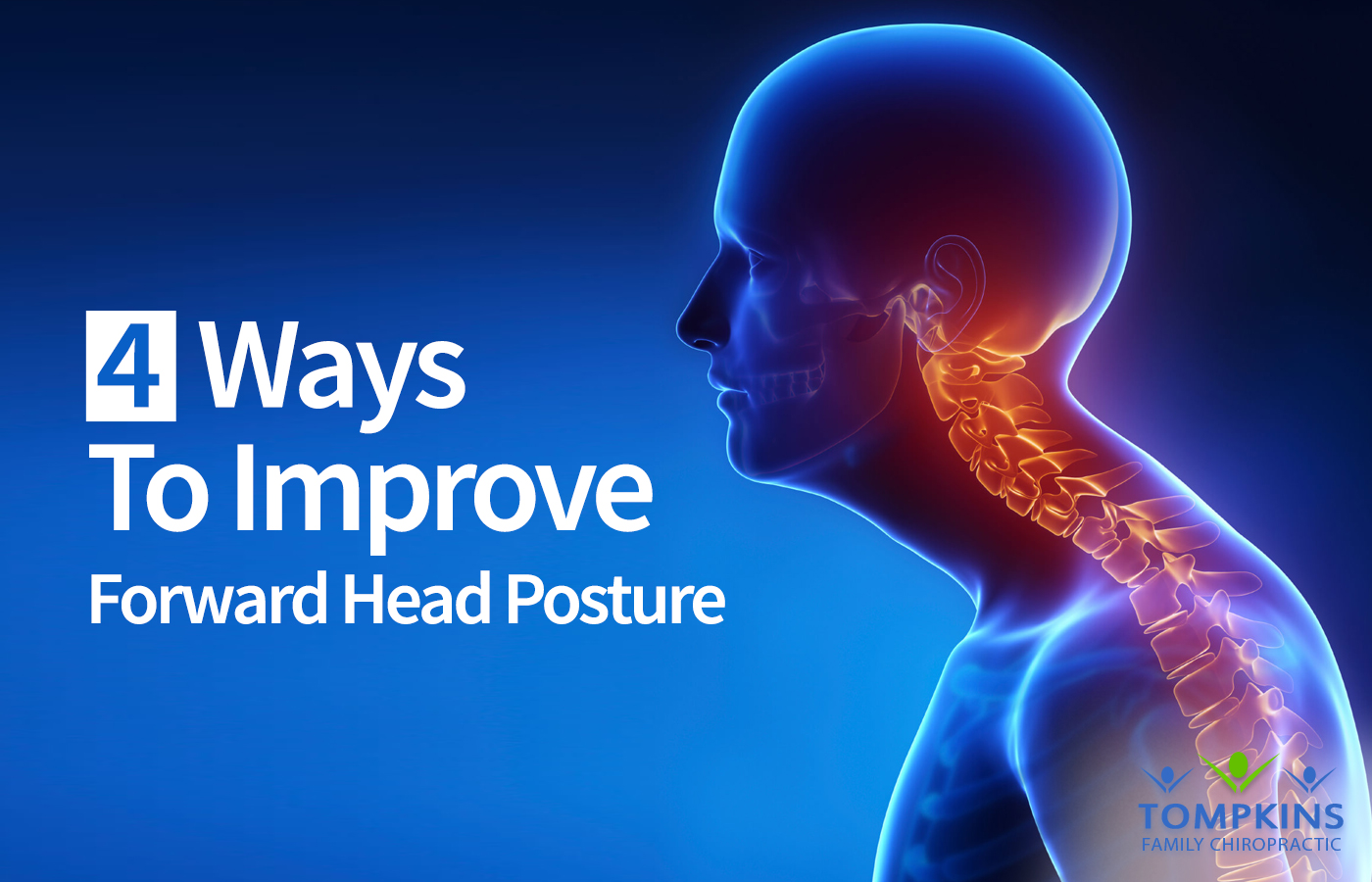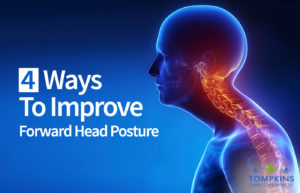
Hey guys, it’s Dr. Emil Tompkins and I want to talk today about how to reduce forward head posture. I thank you for joining me live. Actually, if you’re on right now, you’re probably on the replay, so I thank you for being on the replay, and so four steps to improving forward head posture. The reason why we’re doing this actually, most people don’t come in and say, “I have forward head posture so let’s fix it.” What they come in saying is, “I have headaches. I have migraines. I have issues with pain in my neck. I have disc injuries. I have numbness going down the arms and into the hands,” those kinds of problems. Because of that, they come into our office and we come up with a program and a protocol to help them.

Corrective Program At Your Tucson Chiropractor
Part of that program includes, what we do in our office, with chiropractic care, but part of that includes some very specific exercises that will help to bring the head back. When I talk about forward head posture, just think about, we’ll just … We’ll look here. Posturally, what you should see is the ear should be sitting right over the top of the shoulder. Now, as you can see, this is something I actually have to work on too, and a lot of people do. This is a common thing that we’re seeing especially now in kids because we have our devices. We have iPhones and iPads and all these things that cause us to be in this position. Over time, you spend enough time in this position, your body is going to pretty much get stuck there.
The growing problem
When we started in practice almost 15 years ago, maybe 15 to 20% of people were dealing with this. Nowadays, it’s 60 to 75% of people are dealing with some kind of forward head posture. A lot of it is because of our devices, but there are things that we can do to change that. Let’s talk about a couple of exercises I’m going to give you to help to correct the problems that are causing the forward head posture.
One of the things that happens, as the head moves forward, we have this issue where the extensor muscles in the neck, those extensor muscles in the neck start to get weak. If those extensor muscles in the neck get weak, we’ve got to strengthen them. The way we do that is just with a simple chin tucking exercise. What you do is, well, just look at me from the side here, I’ll kind of hang out in sort of a real forward head position here. Then, what we do is we just tuck our chin and bring our head straight back. You hold that position for about five seconds, and then you relax. You pull back, hold that position for about five seconds, and then relax. You do that over and over again, that exercise, 10 to 20 times. It will start to strengthen those extensor muscles and make a change in your forward head posture.
Tight Sub Occipital Muscles and forward head posture
Now, another reason why we can have forward head posture is because our suboccipital muscles, these muscles in the back of the head, can get really tight. If those suboccipital muscles get tight, what you’ll see is someone whose head is forward and their chin is up. They’re kind of hanging out in this position, and so we’ve got to stretch those suboccipital muscles. You can do that a couple of ways. One of those ways is just with a simple stretch where you’re taking the head and you’re pulling straight down and then to the side. You hold that position for 15 to 20 seconds and you do it on both sides. That will start to stretch those muscles.
Then, to get a little deeper, you’re going to need extra tools. I have this bean bag. You need something a lot better than a bean bag. Maybe a tennis ball or something like that with a little more girth, a little more strength to it, but what you’re going to do is you’re going to lie on this tennis ball, you’re going to lie on your back, put the tennis ball underneath your head, and you’ll just rub that  tennis ball on those muscles, those suboccipital muscles, and that will … I wonder how much noise that made in the video, all that face paper there from the table, but you rub those suboccipital muscles underneath that ball and that’s going to stretch them out and that will start to bring the head back and it will start to correct that issue with those tight suboccipital muscles.
tennis ball on those muscles, those suboccipital muscles, and that will … I wonder how much noise that made in the video, all that face paper there from the table, but you rub those suboccipital muscles underneath that ball and that’s going to stretch them out and that will start to bring the head back and it will start to correct that issue with those tight suboccipital muscles.
Now, the other thing that will cause forward head posture are your SCM muscles, your sternocleidomastoid muscles. These muscles are in the front. They start on the right underneath the ear, they travel to the front of the neck, they connect to your collarbone, your collarbones. To stretch them, you actually use your hands and you just kind of squeeze and stretch. You manually stretch those muscles. Manually stretch that SCM muscle. Over time, you’ll start to see some lengthening of those muscles, and if you lengthen those muscles, it won’t pull your head as far forward.
Pectoral Stretch
The last thing we’re going to do, the other thing that will create this forward head posture, head goes forward, shoulders go forward, is if your pectorals are really tight. What we need to do to correct that is going to be to stretch those pectoral muscles. The way we’re going to do that, we’ll just turn our attention over this way, is we’re going to do a simple doorway stretch. The way to do this doorway stretch, we’ll see if you can see me here, you’ll stand in a doorway, you’ll put your hands on the outside of the doorway, and you’ll just lean forward. As you lean forward, you will stretch your pectoral muscles right here, and the more you do that, the less likely your shoulders are to curl forward and that’s going to open up the chest, give you a lot better posture.
We talked about a couple things. Strengthening the neck extensors, the muscles that pull the neck back. We talked about stretching your suboccipital muscles, these muscles found underneath the skull, these deeper muscles. You use your tennis ball to do that. If you missed any of that in the video, you’ll just go back and watch the replay. It will be there. We also talked about stretching, massaging the sternocleidomastoid muscle, the SCM muscle, it lies right here, and the doorway stretch, just stretch those tight pectorals.
Putting it all together
If you do those exercises, you’ll start to see your forward head posture improve. The reason why we’re going over this isn’t because  forward head posture is that big of a deal, but what it does to your body is the farther forward your head moves, it actually increases the weight of your head. If your head is shifted forward an inch, the weight of your head is actually going to double. Your 12-pound head one inch forward is going to be 24 pounds. That 24 pounds of pressure is going to put more pressure on the neck, more pressure on the upper back, make you more likely to have those headaches, the neck pain, the radiation down the arms, that sort of thing. We don’t want that so we want to reduce that as much as we can.
forward head posture is that big of a deal, but what it does to your body is the farther forward your head moves, it actually increases the weight of your head. If your head is shifted forward an inch, the weight of your head is actually going to double. Your 12-pound head one inch forward is going to be 24 pounds. That 24 pounds of pressure is going to put more pressure on the neck, more pressure on the upper back, make you more likely to have those headaches, the neck pain, the radiation down the arms, that sort of thing. We don’t want that so we want to reduce that as much as we can.
In our office, we do that with chiropractic care. The first step is to correct the positioning of the spine, get things to function the way they’re supposed to, and then the second step along that is to do some exercises to help strengthen and stabilize those muscles like we just showed you here, those four we just mentioned. For some of our patients, we even do subtraction to help train the ligaments to hold things in the right position. Actually, since I’m here, I’m going to go ahead and show you how some of that works. It’s so good that we’re live. Let’s see how we’re going to do this. We’re going to move all that over. Let’s see. We’re going to move all that over this way and let’s see if you can actually see what we’re doing here.
Traction
Here’s our traction. What the traction does is it actually creates more space in the neck and it gives us a little bit more curvature. What we do is something that we do right here in the office, is we get ourselves in a position and we do just a little bit of a squat. Now, what’s so great about this traction, I’m not even sure if you can see me well in that position, but it just gives a little bit of a pull, adds a little bit of curvature, and as you do that, it takes a lot of pressure off of the neck. It corrects the abnormal position that we’re experiencing, improves that curvature, takes pressure off the spine and we start to feel better.
When we put those different pieces together, we make corrections that will last, and that’s our ultimate goal. Not just to make you feel better but to really get things working well, correct the spine so that we really are truly healthy. That’s my goal for you. I thank you, thank you, thank you for joining us today, and I hope you have a great day. We’ll see you soon.
Read Next: 5 Steps to Correct Your Posture

